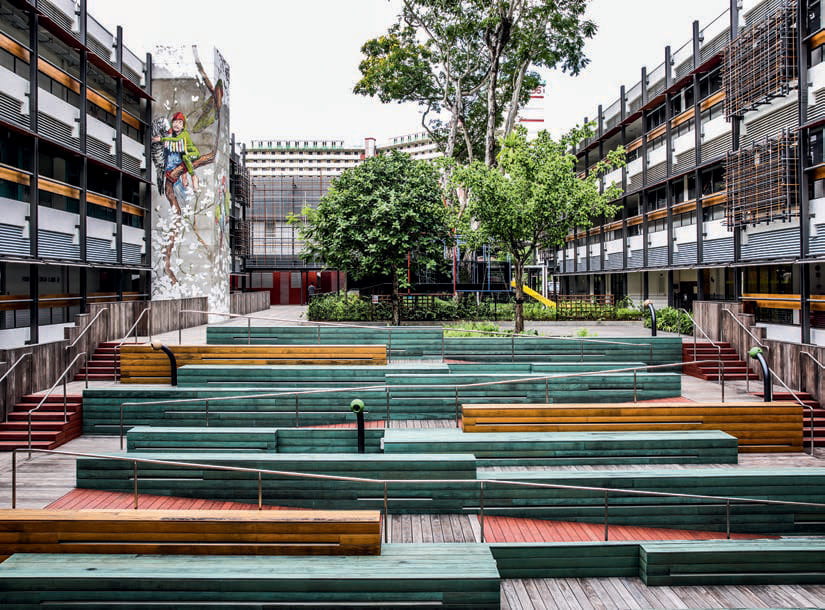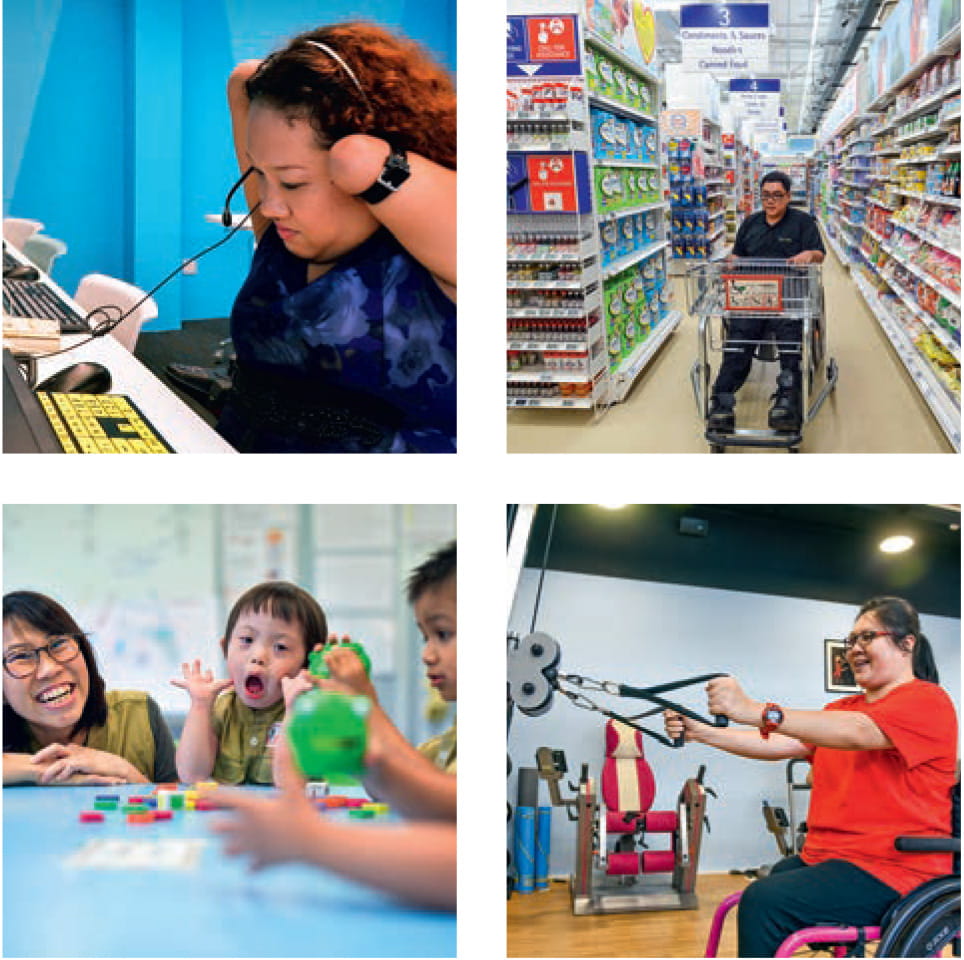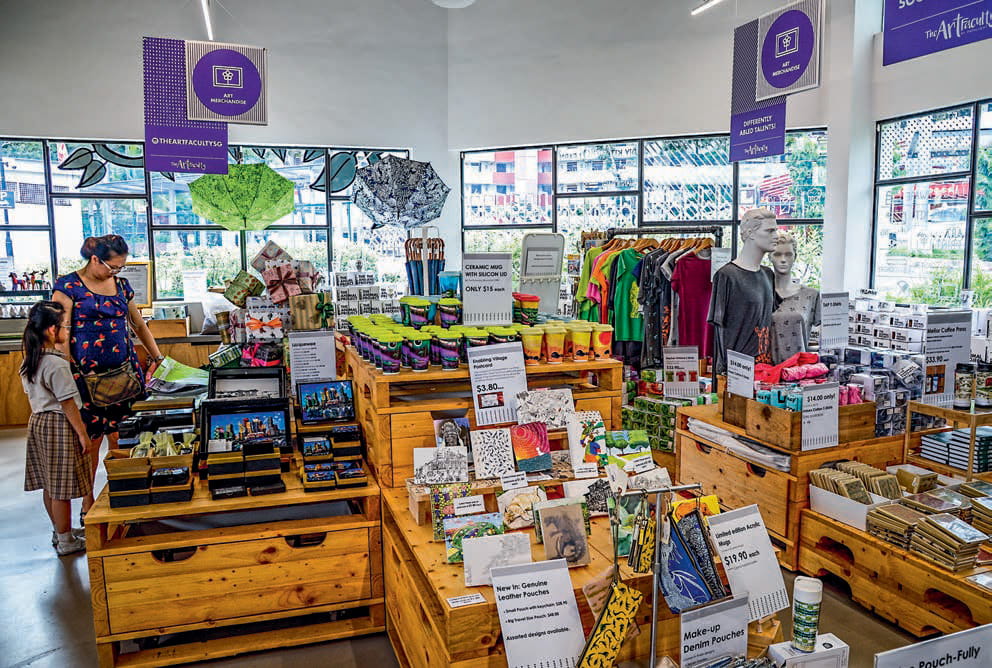Stories > Championing Inclusivity
Championing Inclusivity
Moving and working independently alongside able-bodied peers is a breeze for physically handicapped people in this innovatively designed community space.
BY SOL E. SOLOMON
PHOTOS ENABLING VILLAGE, SPH LIBRARY

The colourful wheelchair-accessible ramp in the EVʼs central courtyard is as functional as it is eye-catching.
cross the globe, people with disability and impairment face myriad challenges in their daily lives – usually because standard urban design generally caters to the able-bodied majority population.
The good news is that universal design – a set of principles that ensures an environment can be accessed, understood, and used to the greatest possible extent by people of all ages, sizes and levels of ability – is gaining traction worldwide. Also called barrier-free design, it enables people with different abilities to move independently and be valued for their contributions to the community. Examples seen in Singapore include ramps (instead of stairs), braille on elevator buttons, tactile paving at MRT stations and bus interchanges, automatic taps/lights, and voice recognition technology.
Singapore’s Enabling Village (EV), which was launched by Prime Minister Lee Hsien Loong in 2015, is a unique 30,000 sq m inclusive community space offering facilities and services that promote interaction between people of varying abilities.
It embodies and supports implementation of universal design, and showcases how assistive and infocomm technology can let persons with disabilities lead more independent and fulfilling lives – in terms of school, work, and daily living.
The EV site initially contained multiple level changes, steps, and thresholds. These were replaced with ramps. Other features, such as special sound systems at the event spaces that are compatible with hearing aids, were installed so that people with and without disabilities can share and enjoy the same facilities and programmes.
Today, all of the EV’s public areas and washrooms are wheelchair-accessible, and wheelchairs are available for loan. Motorised wheelchairs and other personal mobility devices, as well as guide dogs, are welcome everywhere in the EV. Blocks with more than one storey have elevators fitted with braille labels, and even the ATMs have braille labels and earphone ports for blind users.
“The success of the EV sends a powerful message to the broader community that, with the right support, the disabled can contribute meaningfully to society and lead lives that are just as dignified and independent as those of able-bodied persons,” says Catherine Tang, 25, an assistant retail executive at The Art Faculty by Pathlight (TAF). TAF is a retail art gallery featuring artworks, merchandise, and workshops by talented resident artists who have special needs. It trains and develops artists with special needs, and provides them with a means to make a living.
Its flagship store is located in the EV, which retails merchandise showcasing designs by artists with autism. Tang says: “The store provides a real-world setting in which I can hone my customer service skills and learn about various aspects of retail operations. What’s more, I also have opportunities to share the amazing abilities and talents of my peers, who have autism, with the public.”
“The Success Of The EV Sends A Powerful Message To The Broader Community That, With The Right Support, The Disabled Can Contribute Meaningfully To Society And Lead Lives That Are Just As Dignified And Independent As Those Of Able-bodied Persons.”
Catherine Tang, Assistant Retail Executive At The Art Faculty By Pathlight
INCLUSIVELY PLANNED
When planning the EV, SG Enable engaged persons with disabilities to find out the types of services they wished to access, and the activities they felt their community would enjoy. Voluntary welfare organisations, residents, and grassroots leaders in the area were also consulted for ideas, says Ku Geok Boon, the chief executive officer of SG Enable. SG Enable is an agency dedicated to enabling persons with disabilities; the EV is a joint initiative by it and Singapore’s Ministry of Social and Family Development.
Balancing the social imperative of inclusivity with a practical need for commercial sustainability, the EV is home to around 20 social enterprises, voluntary welfare organisations, and corporate and public sector organisations. Many are staffed by a combination of able-bodied and disabled individuals. There are restaurants and a supermarket (which provide training and employment opportunities to persons with disabilities), an inclusive preschool, an inclusively designed gym, and a community outreach clinic. Other retail and lifestyle services are also available. By shopping or dining at the EV, visitors can support the social businesses there.

The colourful wheelchair-accessible ramp in the EVʼs central courtyard is as functional as it is eye-catching.
Tang says: “The atmosphere at the EV is friendly and warm. Services for people with special needs, offered by various social service organisations, are all easily accessible under one roof. For me, there is a real sense of camaraderie among everyone working here. We do not see one another as mere co-tenants, but as colleagues and friends who view and support one another as equals.”
Visitors to the EV can also enjoy its excellent landscaping, which boasts lush greenery, ponds and cabanas, a walking trail, outdoor fitness corners, and even an inclusive playground.
A WIDER PERSPECTIVE
To promote engagement with, and interaction among, persons with differing levels of ability, the EV also holds community events that are open to the public. And because it is just a fiveto 10-minute walk from Redhill MRT Station, and close to community touchpoints such as senior activity centres, homes, schools, and offices, it has been able to serve and engage not just persons with disabilities, but also the wider international community, Ku says.
It’s notable that the international community has shown interest in the EV, too, and this has flowered into mutually beneficial collaborations. One such event was the Arts and Disability Forum held at the EV in April 2017, an international event jointly organised by the National Arts Council, the British Council, and the Singapore International Foundation. Ku says it gathered arts practitioners from Singapore and overseas for an exchange of ideas on issues such as audience growth, inclusive arts programming, and funding.

Most of the merchandise on sale at The Art Faculty by Pathlight features designs by students of Pathlight School, which caters to high-functioning children with autism.
“The EV has also hosted visitors from foreign ministries, voluntary welfare organisations, and schools, as well as journalists. Most have been inspired by how the EV has enabled the community to learn to be more inclusive, and how we are promoting interaction and empathy. Our focus on training and the employment of persons with disabilities also demonstrates how they can be contributing members of society when provided with opportunities and support,” Ku adds.
“The EV is a bold social innovation. Through our services and facilities, we hope that visitors will gain a better understanding of the possibilities that can be made available to persons with disabilities, and open their hearts and minds to build a more inclusive Singapore – and a more inclusive world.”

Christopher Hills (centre), a quadriplegic athetoid cerebral palsy sufferer who runs a video editing business, co-led a workshop on using assistive technology at the EV in June.
SHARING INIGHTS
One of the Singapore International Foundationʼs (SIFʼs) initiatives is Singapore Insights, a series of thematic visits and dialogue that introduces the international community in Singapore to the cityʼs soul and culture of innovation. Itʼs one way to facilitate mutual understanding between Singaporeans and world communities.
The annual Singapore Insights: Social Innovation and Enterprise was started in August 2016, and involves introducing Chinese scholars from the Siyuan Programme to the important work that the SIF does in helping to bridge communities.
On Aug 30 last year, 24 students and four teachers from Fudan University, Shanghai, were given experiential demonstrations of Singaporeʼs innovations in addressing social needs relating to disabilities. The highlight of the day was a tour of the Enabling Village, during which participants could try out examples of assistive technology. Attending one of the workshop sessions was Minister for Communications and Information Mr Yaacob Ibrahim (above, left).
The students also participated in a simulation exercise to experience how visually impaired individuals navigate via their other senses. The session, led by Etch Empathy (an alumnus of SIFʼs Young Social Entrepreneurs programme), gave them new perspectives on how companies can play a role in creating an inclusive society.
